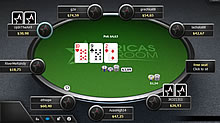Many poker players find running pot-odds calculations mid-game a big hassle. It perhaps feels far easier to ignore the maths and make the majority of our decisions based on feel.
Pot-odds are extremely important however. Although considered a basic poker concept, the best players use accurate pot-odds calculations on a regular basis. Let’s run a quick recap on using pot-odds and keep it as short and pain-free as possible.
What are Pot-Odds?
Pot odds describe the percentage of the total pot we are investing.
If there is $100 in the middle and our opponent bets $50 we would be investing 25% of the total pot on a call ($50/$200). Our pot-odds is hence 25%.
In all-in situations we need to win more frequently than our pot-odds percentage.
If we are investing 25% of the pot, we need to win at least 25% of the time when calling an all-in bet. What could be simpler!? If we win exactly 25% of the time our call is break-even. If we win more than 25%, this is when we start to profit.
We can completely ignore ratios!
We might be wondering where all of the “two to one” and “three to one” ratio-style pot-odds come in to the equation. Perhaps this is how we first learnt to calculate pot-odds. Ratios are not required, we can run full pot-odds calculations using only percentages. Using ratios adds an unnecessary extra step into the calculation. We are going to need to convert that ratio into a percentage in order to compare it to our pot-equity anyway! Why not just skip the extra step and express pot-odds as a percentage? Sometimes this easy simplification is all that a player needs in order to be able to use pot-odds on a regular basis.
So as a recap
1. Calculate how often we will win when calling. (Usually referred to as “pot-equity”.)
2. Calculate what percentage of the pot we are investing.
3. Compare the two numbers. If our pot-equity percentage is higher than the percentage of the total pot we are investing, we have a pot-odds call.
Calculating Pot-Equity
We can know our pot-equity (chance to win when all-in) precisely using an equity calculator. Of course, we won’t have time to use one in game, so we can use the two-times and four-times rules to make estimates on the fly. Here is how it works.
1. Count the number of outs which are likely to give us the best hand.
2. Multiply our number of outs by 2 if all-in on the turn.
3. Multiply our number of outs by 4 if all-in on the flop.
Example: We are all-in on the turn with a flush-draw. We have 9 outs to make our flush. We usually have around 18% pot-equity (9 * 2). We therefore should not invest more than 18% of the total pot on a call.
Final Pointers
1. Pot odds is for all-in situations only. If there are still chips to play for after we make our call, we need to be running an implied-odds calculation instead.
2. When estimating pot-odds be careful regarding outs which are dominated with a high frequency. For example, we have a one-card five-high flush draw on the turn. Yes, there are 9 cards which give us a flush, but the possibility of our opponent having a better flush draw is high. Dominated outs should either be ignored or “discounted” (i.e we only count a fraction of the out when making our pot-equity estimate).
3. Mental arithmetic is the ability to generate quick answers to maths problems by simplifying. For example, imagine we are investing $50 into a $212 pot. Rather than get held up trying to find a precise answer, we can just call it $50/$200 and say that we are investing “roughly 25% of the pot”. Without this technique, pot-odds calculations can feel insurmountable.




